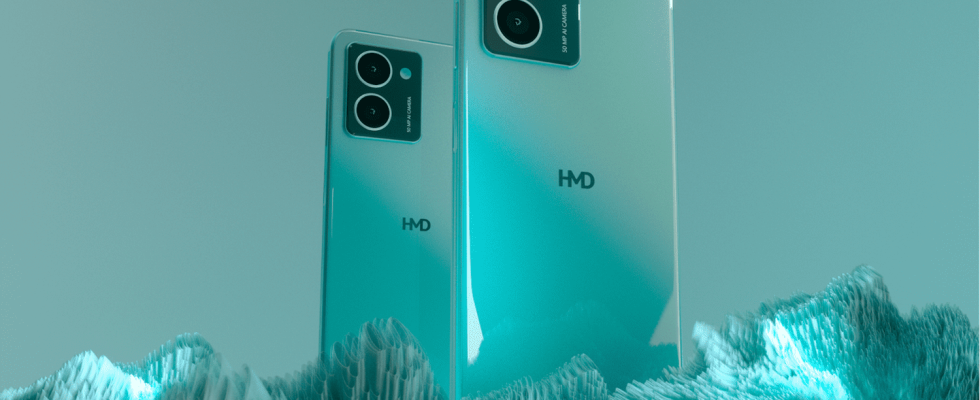The Finnish manufacturer HMD, which manufactures Nokia smartphones, is launching models under its own name. With two major advantages: very low prices and great ease of repair, to make them last longer.
The Human Mobile Devices brand, or more commonly HMD, probably means nothing to you. On the other hand, if we say Nokia, then you see more precisely what it is about. HMD is none other than the manufacturer that has been manufacturing and marketing Nokia smartphones under license since 2016, shortly after Microsoft threw in the towel with Nokia Windows Phones. Moreover, HMD, a Finnish company, counts former Nokia executives among its founders. Its catalog includes smartphones, of course, but also tablets and feature phones. These devices are the revisited and modernized versions of the legendary Nokia 3310, 8210 and other 5310 which made the success of the Nokia brand before the era of smartphones. But that is no longer enough for HMD which has just decided to launch its own models under its name. But let the nostalgics rest assured: the Finn is not abandoning the Nokia brand which will continue alongside HMD-branded mobiles.
HMD: very affordable smartphones
So, what else can a new smartphone brand have to offer in an already very crowded, even saturated market? There is no question here of playing on the buzz in the have-you-seen-me way like Nothing and its flashing smartphones. HMD’s approach is, unsurprisingly, very close to what Nokia has been offering for years but also to the concept established by the Dutch Fairphone. The company focuses on repairability with the ambition of seeing you keep your mobile longer by repairing it, if necessary, yourself. It therefore offers three new smartphones but only two will be marketed in France: The Pulse and the Pulse Pro.
First good news, the prices. The first will be sold at 130 euros and the second at 160 euros. We are far from the 700 euros requested for the Fairphone 5. But it is also true that HMD’s smartphones have a lighter technical sheet. On the program, entry-level smartphones equipped with a 6.56-inch IPS LCD screen with a definition of 1480 x 720 pixels for a resolution of 251 ppi and refreshed at 90 Hz. Under the hood, a Unisoc processor T606, equivalent of a Snapdragon 460 released in 2017, is in action. This SoC engraved in 12 nm with 8 cores on board (1.6 GHz) supported by a Mali G57 MP1 GPU is also used in the Nokia G22 and only allows 4G connection. The Pulse model (for short) is based on 4 GB of RAM and 64 GB of storage space (expandable by microSD card). On the back, it features a 13 Mpx (f/1.8) photo module and a depth sensor. On the front, the selfie camera benefits from an 8 Mpx (f/2.0) sensor. The Pulse Pro model has 8 GB of RAM and 128 GB of storage space, also expandable. For photos, it’s better with a 50 Mpx (f/1.8) back module and a 50 Mpx (f/2) selfie camera as well. Both smartphones come with Android 14 without any software overlay.
HMD: smartphones that are easy to repair
So what differentiates these entry-level smartphones from the myriad of other models – most of them Chinese – that can be found everywhere else? The care taken in their design to allow easy repair. We experienced this during the HMD presentation in Paris. Simply remove the SIM card drawer and slide a pick around the edge to unclip the back of the device. Anyone can now access the insides of the mobile. HMD thus makes it possible to replace the battery, the screen and the USB-C connection port, the three elements which most frequently encounter failures on a smartphone. And you don’t need to be a great handyman to achieve it. Opening the smartphone, removing 9 Phillips screws, replacing the battery and closing everything only took us 5 minutes in hand. Easy.
As for spare parts, HMD relies on the expertise of the American site iFixit. It is he who will be responsible for providing the parts through the HMD sites but also the tutorials to follow the different stages of the manipulations, also carried out in French. A mandatory step to maintain the device warranty. It will be possible to purchase complete kits including the part to be replaced with the necessary tools. In terms of prices, it remains reasonable. A replacement battery is offered for around 25 euros, a screen for around 50 euros and the USB connection port for around 20 euros. The practice is already in application for Nokia devices.
Small downside, however. While HMD promotes the durability of its devices, the brand only offers two years of Android updates and five years of security patches. The reason is surely the choice of the Unisoc T606 SoC which should be a little more difficult to run versions of the system beyond Android 16. The HMD Pulse is available from this Wednesday, April 24. The Pulse Pro model should arrive a little later, without further details.



